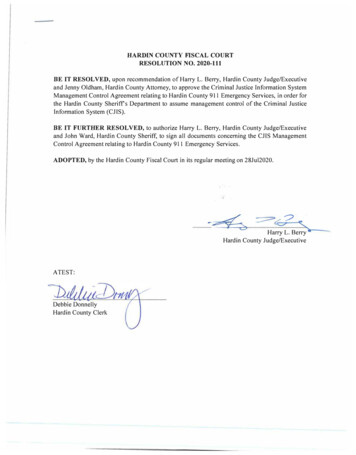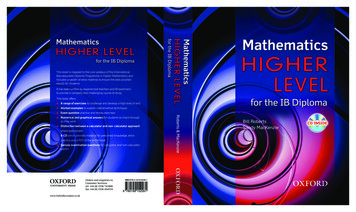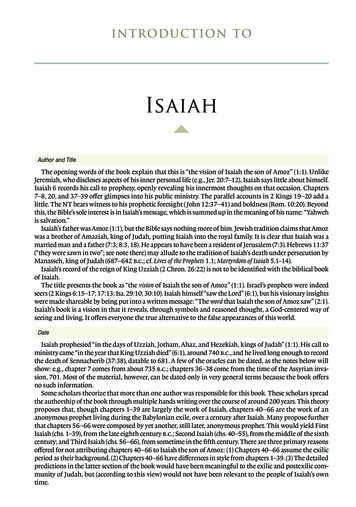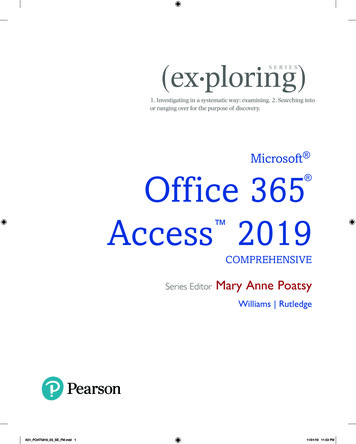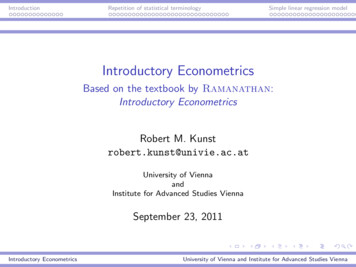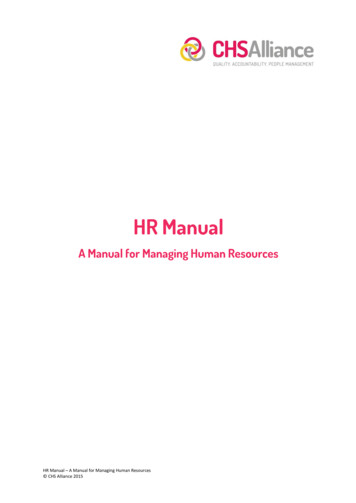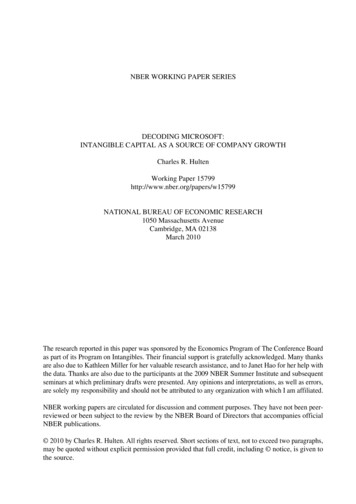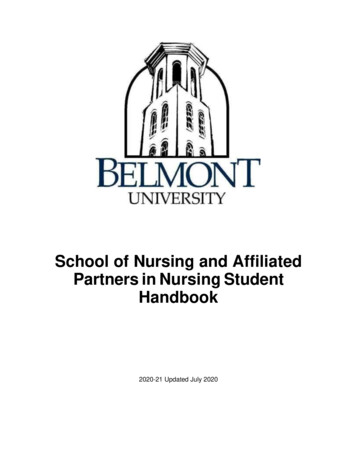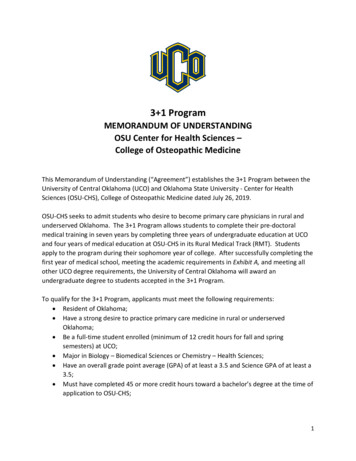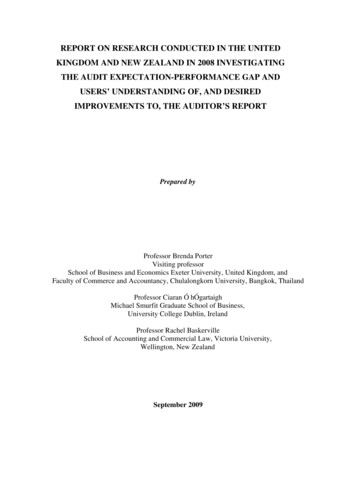
Transcription
REPORT ON RESEARCH CONDUCTED IN THE UNITEDKINGDOM AND NEW ZEALAND IN 2008 INVESTIGATINGTHE AUDIT EXPECTATION-PERFORMANCE GAP ANDUSERS’ UNDERSTANDING OF, AND DESIREDIMPROVEMENTS TO, THE AUDITOR’S REPORTPrepared byProfessor Brenda PorterVisiting professorSchool of Business and Economics Exeter University, United Kingdom, andFaculty of Commerce and Accountancy, Chulalongkorn University, Bangkok, ThailandProfessor Ciaran Ó hÓgartaighMichael Smurfit Graduate School of Business,University College Dublin, IrelandProfessor Rachel BaskervilleSchool of Accounting and Commercial Law, Victoria University,Wellington, New ZealandSeptember 2009
ACKNOWLEDGEMENTSThe authors acknowledge with thanks the financial support provided for this research by theInternational Auditing and Assurance Standards Board (IAASB) and the American Instituteof Certified Public Accountants (AICPA).* They also acknowledge and thank ProfessorsDouglas Prawitt and Mark Taylor, Chairs of the Research Committee responsible for theproject, and Sharon Walker and Sherry Boothe and their teams at the AICPA, for theirassistance and support.Additionally, they express sincere thanks to the many people who assisted with thedevelopment of the survey instrument. The authors are particularly grateful to the followingpeople who generously gave their time, thoughts and expertise to assist with the research:Warren Allen, Philip Ashton, Fred Hutchings, Dennis Keall, Stephen Leonard and TimFairhall and also all to of those who participated in the pilot study of the questionnaire in theUnited Kingdom and New Zealand. Special thanks are also due to Ben Lee and MarcoOgden, two post-graduate students at Victoria University, New Zealand, who assisted withthe literature review and administration of the experiment in New Zealand and to DrMargaret Ó hÓgartaigh who was of great assistance to the authors from the outset of the study.Conducting a mail survey on the scale involved in this project entails an enormous amount ofadministrative work. Very grateful thanks go to Eileen Lockerd, the project’s researchassistant, and also to Marita Lotz, who managed the research budget, for their unfailingly calm,thorough and efficient assistance, and for always being prepared to go the ‘extra mile’.Finally, the authors acknowledge and thank the many individuals who took time to completethe questionnaire and participate in the experiment. Without their help the research reportedhere would not have been possible.* A copy of the substantive section of the proposal which formed the basis for the research reportedherein is provided in Appendix G. The IAASB/AICPA Research Committee adopted Part 1 of theproposed research project.i
EXECUTIVE SUMMARYBackground to, and objectives and key findings of, the researchCriticism and a loss of confidence in external financial statement audits has characterisedmost of the western world since the corporate debacles of the last couple of decades of the20th and early years of the 21st century. The criticism and loss of confidence in the auditfunction results from a mismatch or gap between society’s expectations of auditors (whetherreasonable or not) and what they perceive auditors to deliver. This gap may conveniently betermed the audit expectation-performance gap. The most visible element of a financialstatement audit is the auditor’s report and part of the mismatch between society’sexpectations of auditors and what it perceives they deliver may result from financialstatement users and other interested parties in society failing to understand the messagesconveyed by an auditor’s report.Against this background, research was conducted to:1. ascertain the structure, composition and extent of the audit expectation-performancegap in the United Kingdom (UK) and New Zealand (NZ) in 2008;2. identify and explain differences in the structure, composition and extent of the auditexpectation-performance gap: (a) in the UK and NZ in 2008 (a cross-cultural study)and (b) in NZ in 1989, 1999 and 2008, and in the UK in 1999 and 2008 (longitudinalstudies);3. ascertain society’s (and, more particularly, financial statement users’) understandingof the message(s) conveyed in a standard unqualified auditor’s report;4. identify changes to the format and wording of auditors’ reports desired by society(and, more particularly, financial statement users).Key findings of the research are that, although the structure and composition of the auditexpectation-performance gap in the UK and NZ in 2008 were similar, the gap wassignificantly wider in NZ than in the UK. This finding differs markedly from that in 1999when the extent of the gap in the two countries was found to be essentially the same.Between 1999 and 2008 the gap in the UK narrowed substantially while that in NZ widenedslightly. The research findings suggests that the difference in the change in the gap in the UKand NZ may result from differences in the monitoring of auditors’ performance in the twoii
countries and/or from greater publicity given to corporate, and financial reporting issues withaudit implications in the UK.A further finding of the research is that, notwithstanding the use of the long form audit reportas an educational tool, financial statement users’ (and other interest groups’)misunderstanding of the audit function and auditors’ responsibilities persists.This issupported by a further finding of the research, namely, that the content of a standard auditor’sreport has little impact on financial statement users’ understanding of the messages conveyedin the report.This executive summary concludes with some recommendations, based on the researchfindings, on ways in which the audit expectation-performance gap might be narrowed and theauditor’s report may be made more useful to those who read and rely on it.Literature reviewAn extensive review of extant literature relating to the audit expectation gap and the standardauditor’s report was undertaken. Its main findings are as follows:1. Numerous studies of the audit expectation gap and its contributing factors have beenconducted since 1970 in many countries of the world. They have found that, in general,financial statement users and other interest groups in society have little understanding ofthe audit function or auditors’ responsibilities.They have also found that, notwithstanding explanatory paragraphs being included in the auditor’s report since the endof the 1980s/early 1990s, their understanding has not increased over time. The studiesfurther found that institutional and cultural factors influence society’s expectations ofauditors and how it perceives the standard of their performance.2. The long form audit report was adopted in the United States of America in 1988 andinternationally during the early 1990s as a means of educating financial statement usersabout the respective responsibilities of the directors and auditor for the financialstatements and about the audit process. However, this generated concerns about theauditor’s report becoming a long, complex and less understandable document. Concernswere also raised about the standardised wording of auditors’ reports which resulted iniii
them being treated as a symbol rather than read. The literature review further revealedthat in the mid 2000s financial statement users (at least in the UK) were very critical ofstandard audit reports; they were considered to be too long and too standardised, andfailed to include company specific information – in particular, more of the informationwhich auditors routinely report to the auditee’s directors (or audit committee). As aconsequence, audit reports were regarded as having little value.Survey investigating the audit expectation-performance gapAgainst this background, the audit expectation-performance gap was investigated by meansof a mail survey in the UK and NZ in 2008 which involved four broad interest groups –auditors, auditees, and financial community and non-financial community audit beneficiaries.The questionnaire was mailed to 1,610 participants in the UK and 1,555 in NZ and obtainedusable response rates of 14 per cent and 29 per cent, respectively. Tests for non-responsebias were conducted and no such bias was found. Nevertheless, the robustness of the surveyfindings are tempered, to an extent, by the low response rates.The survey instrument included an integrated list of 55 actual and potential responsibilities ofauditors and, for each, the respondents were asked to indicate: (i) whether the responsibility isan existing responsibility of auditors, (ii) if so, how well the responsibility is performed and(iii) whether the responsibility should be a responsibility of auditors.It was found that the interest groups in the UK and NZ identified similar responsibilities asresponsibilities of auditors – but both groups were erroneous in some respects. The surveyfound that in the UK about 17 per cent, 34 per cent, 38 per cent and 60 per cent, respectively,of the auditor, auditee, financial community and non-financial community groups were inerror or uncertain about auditor’s existing responsibilities. This compares with 22 per cent,27 per cent, 37 per cent and 57 per cent for the equivalent groups in NZ.The audit expectation-performance gap has two primary components: the ‘reasonablenessgap’ (consisting of responsibilities which society unreasonably expects auditors to perform)and a performance gap. The latter is subdivided into the ‘deficient standards gap’ (comprisedof responsibilities that are reasonably expected but not required of auditors) and the ‘deficientperformance gap’ (constituted by existing responsibilities of auditors which society perceivesiv
auditors perform deficiently). Using the interest groups’ responses to the questions relatingto the standard of auditors’ performance and the responsibilities they should perform, thesurvey found that, in 2008, the deficient performance, deficient standards and reasonablenesscomponents contributed 3 per cent, 45 per cent and 52 per cent, respectively, to the auditexpectation-performance gap in UK, and 7 per cent, 43 per cent and 50 per cent, respectively,to the audit expectation gap in NZ.Comparing the results of the 2008 survey with those of an equivalent survey conducted in theUK and NZ in 1999, it was found that, while in 1999 the extent of the audit expectationperformance gap in the UK and NZ differed by only two per cent, in 2008 it was 36 per centwider in NZ that in the UK. Analysis of this finding revealed that in NZ the deficientperformance gap increased by 23 per cent over the period but in the UK it decreased by 72per cent; similarly, in NZ the reasonableness gap increased by 17 per cent between 1999 and2008 but in the UK it decreased by 31 per cent. Considering possible reasons for thesedifferences it is postulated that they result:1. In the case of the deficient performance gap, from more stringent monitoring ofauditors’ performance, together with annual reports of the monitoring process and itsoutcomes being placed in the public domain, in the UK. In NZ monitoring seems to bemore lenient and no reports of the monitoring process or its outcomes are available tothe public.2. In the case of the reasonableness gap, from UK society possessing a greater awareness,and being engaged more widely in debate and discussion, of corporate, financial andeconomic issues in general, than in NZ.As for the reasonableness and deficient performance gaps in the UK and NZ in 2008, theresponsibilities comprising the deficient standards gap were very similar. The majority ofthese reasonably expected, but not required, responsibilities of auditors involve reportingmatters that are within the auditor’s knowledge to an appropriate authority when it is in thepublic interest to do so and/or in the auditor’s report. The matters to be reported to anappropriate authority concern untoward events encountered during an audit (such asembezzlement of the company’s assets, or other illegal acts, by the directors/seniormanagement, or deliberate distortion of the financial statements). Given the profession’scontention that it is committed to the public interest, it does not seem unreasonable forauditors to be required to override their duty of confidentiality to their client and reportv
matters to a regulatory authority when it is in the public interest to do so.The responsibilities contributing to the deficient standards gap which involve auditorsreporting, in the audit report, information that is within their knowledge concern reporting: on the effectiveness of the auditee’s internal financial controls; on the adequacy of the auditee’s procedures for identifying financial risks; significant difficulties encountered during the audit, and the theft of a material amount of the auditee’s assets by non-managerial employeesdiscovered during an audit.These matters accord with those identified in the literature review – that is, company specificinformation that financial statement users want auditors to report, not just to auditee’sdirectors (or audit committee), but in their audit reports,.Experiment to ascertain financial statement users’ understanding of the messagesconveyed in audit reportsTo examine financial statement users’ understanding of the messages conveyed in a standardunqualified auditor’s report, an experiment was conducted in the UK and NZ in 2008. Theexperiment involved 252 MBA students (who are generally seen in the academic literature assurrogates for reasonably knowledgeable financial statement users); 125 came from fouruniversities in NZ and 127 from three universities in the UK.The participants wererandomly allocated to one of four groups. Each group was provided with an identical set offinancial statements and one of four variants of the standard unqualified auditor’s report. Theexperiment task involved the participants responding to 10 statements related to the messagesconveyed by auditors’ reports.The results of the experiments reveal that:1. The content of the auditor’s report does not have a significant influence on themessages understood by reasonably knowledgeable users of financial statements withregard to (i) the nature of the audit process, (ii) the respective roles of the auditor andthe directors, and (iii) the risk of investing in the reporting entity.2. Those who do not, or only rarely, read financial statements are less inclined to agreethat the auditor guarantees (i) the accuracy of the financial statements and (ii) thecontinued existence of the reporting entity, than those who read financial statementsvi
more regularly.By their nature, the results of this experiment are tentative and indicative rather thanconclusive evidence of the opinions of reasonably knowledgeable investors regarding themessages conveyed by an auditor’s report.Research respondents’ views on items of importance in audit reports and how auditors’reports could be made more usefulAs a supplement to both the survey and the experiment, the research participants were askedto identify the elements of the auditor’s report they find most useful, the information theywould prefer to be omitted and any additional information they would like included. Perhapsnot surprisingly, the auditor’s ‘true and fair’ opinion was identified as the most importantelement of an audit report. However, a majority of the respondents also identified among themost important elements of an auditor’s report: the statement of the auditors’ and directors’ responsibilities, the basis of the auditor’s opinion, identification of the firm which conducted the audit, and the types of, and reasons for, audit qualifications.Given the findings of the survey and, more particularly, the experiment – that statementsexplaining the respective responsibilities of the directors and auditor for the financialstatements and the audit process have little, if any, influence on financial statement users’understanding of these matters, the first two items in the list above are somewhat puzzling.With respect to information that should be omitted from the auditor’s report, the two opinionsmost frequently expressed by the respondents were: (i) nothing should be removed; and (ii)everything other than the auditor’s opinion should be removed.In relation to additional information that respondents would like included in auditors’ reports,the most commonly expressed opinions were that the report should contain an expression ofthe auditor’s opinion on (i) the effectiveness and adequacy of the auditee’s internal controlsand internal audit function, and (ii) the auditee’s culture, the effectiveness of its governancestructure and an assessment of management’s capability/adequacy.vii
Some survey respondents also offered additional comments on auditors’ reports whichcorrespond closely with those identified during the literature review as views expressed in theUK to the Audit Quality Forum’s Working Group on Auditor Reporting, namely: thatauditors’ reports: are too formulaic and rather bland, do not give any company specific information, do not give the impression that the auditee’s financial statements have been criticallyexamined, need to be expressed more simply and clearly so they may be more readily understood, should commence with the auditor’s opinion, and should not contain statements of the directors’ and auditors’ responsibilities or adescription of the audit process – this material should be moved elsewhere where itmay be accessed by those who wish to do so.RecommendationsAs discussed in more detail in Chapter 9, based on the research findings it is recommendedthat the auditing profession:1. Ensures that: stringent monitoring of auditors’ performance is implemented or, where alreadyimplemented, continued; appropriate sanctions are imposed on errant auditors found by the monitoringprocess; reports on the monitoring process and its outcomes are placed in the public domain.Given that in most countries there is a system of regulating company auditors and audits,the profession will need to work collaboratively with the relevant regulatory authority toimplement this recommendation.2. Clarifies and gives increased focus to the auditor’s opinion by moving the opinionparagraph to the beginning of the auditor’s report.3. Ensures the wording of auditors’ reports is clear and simple so that it may be readilyunderstood.4. Follows, but extends, the example of the Auditing Practices Board in ISA (UK andIreland) 700 (Revised): The Auditor’s Report on Financial Statements, and replaces theviii
explanatory paragraphs on the directors’ and auditors’ responsibilities and on the auditprocess in the auditor’s report with a cross-reference to a location where the informationis accessible to anyone who wishes read it.5. Changes auditing standards to include within auditors’ responsibilities reporting: in the audit report more company specific information – especially more of theinformation currently provided to the auditee’s directors (or audit committee); to an appropriate regulatory authority untoward matters that are uncovered during anaudit when it is the public interest to do so.6.Seeks opportunities to stimulate and encourage debate and discussion among a widesection of society about corporate, financial and economic matters in general andrelated audit issues. This may be facilitated by discussion or consultation papers and/orinformative reports on topical issues about these matters. It may also be fostered bygiving informative, interesting presentations to societal groups such as shareholders’and business associations, Rotarians, and other similar groups. The current economicdownturn and its impact on virtually every section of society seems to provide anopportunity for auditors to be engaged in discussions and/or presentations where theycan explain the role auditing can (and cannot) play in helping to restore confidence infinancial markets and, thereby, assist with economic recovery.ix
TABLE OF CONTENTSPageAcknowledgementsExecutive SummaryChapter 1 Introduction1.1 Background to the research1.2 Research objectives1.3 Outline of this reportChapter 2 Prior research investigating the audit expectation gap and development ofthe standard auditor’s report2.1 Introduction2.2 Prior research investigating the audit expectation gap2.2.1 The audit expectation gap – not a new phenomenon2.2.2 Definition of the audit expectation (expectation-performance) gap2.2.3 Evidence of the existence and composition of the audit expectation gap2.2.4 The effect of institutional and cultural factors on society’s expectations ofauditors and perceptions of their performance2.2.5 Conclusions from studies investigating the audit expectation gap2.3 Prior research investigating development of the standard auditor’s report2.3.1 The case for using the auditor’s report as an educational tool2.3.2 Development to 1988 – The demise of the short form auditor’s report2.3.3 Development 1988 to 1993 – International adoption of the long form report2.3.4 Development 1993 to 2004 – The adequacy of the long form report underquestion2.3.5 Development in 2004 and beyond – A ‘new look’ long form audit report and thenext step2.4 SummaryChapter 3 Audit expectation-performance gap: Research methodology3.1 Introduction3.2 Selection of the survey samples3.3 Survey instrument3.4 Coding and testing the survey results3.5 SummaryChapter 4 Audit expectation-performance gap: Survey results4.1 Introduction4.2 Auditors’ existing responsibilities4.2.1 Identification of auditors’ existing responsibilities4.2.2 Interest groups’ knowledge of auditors’ existing responsibilities4.2.3 The interest groups’ ‘knowledge gap’4.3 Interest groups’ opinions about auditors’ performance of their responsibilities4.4 Interest groups’ opinions about the responsibilities auditors should perform4.5 SummaryChapter 5 The audit expectation-performance gap in the United Kingdom and NewZealand in 20085.1 950525252536065707981
5.2Identifying the components of the audit expectation-performance gap in the UK andNZ in 20085.2.1 Ascertaining society’s expectations of auditors5.2.2 Ascertaining the responsibilities that are reasonably expected of auditors5.2.3 Reasonableness gap component of the audit expectation-performance gap5.2.4 Deficient standards gap component of the audit expectation-performance gap5.2.5 Deficient performance component of the audit expectation-performance gap5.3 Extent of the audit expectation-performance gap, and its components, in the UK andNZ in 20085.4 SummaryChapter 6 Changes in the audit expectation-performance gap in New Zealand 19892008 and in the United Kingdom 1999-20086.1 Introduction6.2 The survey instrument for the 1989 and 1999 studies6.3 Changes in the audit expectation-performance gap in NZ between 1989 and 2008 andin the UK between 1999 and 20086.3.1 Changes in the audit expectation-performance gap in NZ between 1989 and 19996.3.2 Changes in the audit expectation-performance gap in NZ between 1999 and 20086.3.3 Changes in the audit expectation-performance gap in the UK between 1999 and20086.4 SummaryChapter 7 Users’ understanding of messages conveyed by the standard unqualifiedauditor’s report7.1 Introduction7.2 Research methodology to ascertain financial statement users’ understanding of themessages in auditors’ reports7.3 Experiment results7.4 SummaryChapter 8 Desired changes to auditors’ reports8.1 Introduction8.2 Research methodology to identify desired changes to auditors’ reports8.3 Research findings8.3.1 Items of importance in an auditor’s report8.3.2 Information to be omitted from auditors’ reports8.3.3 Additional information to include in auditors’ reports8.3.4 Additional comments on auditors’ reports provided by survey respondents8.4 SummaryChapter 9 Conclusions and recommendations9.1 Introduction9.2 Summary of the research project9.3 Implications of the research findings9.4 Limitations of the research9.5 Recommendations on ways to narrow the audit expectation gap and to enhance thevalue of an auditor’s report9.5.1 Narrowing the deficient performance gap9.5.2 Narrowing the reasonableness 80
9.5.3 Narrowing the deficient standards gap and enhancing the value of the auditor’sreport9.6 ConclusionReferencesAppendicesA1Standard audit report similar to that used internationally until the early 1990sA2Standard audit report similar to that adopted internationally in the early 1990sA3Standard audit report similar to that adopted internationally during the early 2000sA4Standard audit report that complies with ISA 700 (Revised)A5Standard audit report which complies with ISA(UK and Ireland) Revised:BCopy of the questionnaire to investigate the audit expectation-performance gapCAuthority for classifying suggested responsibilities as existing responsibilities ofauditorsDAudit reports used in the experimentsECopy of the experiment instrument used to investigate financial statement users’understanding of the messages conveyed by standard unqualified auditors’ reportsFiItems of importance in the audit report identified by the UK survey respondents andexperiment subjectsFiiItems of importance in the audit report identified by the NZ survey respondents andexperiment subjectsGThe substantive section of the research proposal which forms the basis of the researchreported in this 37242
Figures1Structure of the audit expectation-performance gap2Proportion of the audit expectation-performance gap contributed by its components in1989 in NZ and in 1999 in NZ and the UK3The Means of Interest Group Responses with Respect to Auditors’ Existing Duties4ai Groups included in the survey in the United Kingdom and their response rates4aii Profile of the UK interest groups’ experience with the audit function and interest infinancial statements and audit reports4bi Groups included in the survey in New Zealand and their response rates4bii Profile of the NZ interest groups’ experience with the audit function and interest infinancial statements and audit reports5a Responsibilities interest groups in the UK consider to be auditors’ existingresponsibilities5b Responsibilities interest groups in NZ consider to be auditors’ existing responsibilities6a ‘Knowledge gap’ of auditors’ interest groups in the UK6b ‘Knowledge gap’ of auditors’ interest groups in NZ7a Assessment of auditors’ performance in the UK based on means of interest groupresponses and proportion of interest groups signifying responsibilities are poorlyperformed7b Assessment of auditors’ performance in NZ based on means of interest groupresponses and proportion of interest groups signifying responsibilities are poorlyperformed8a Responsibilities interest groups in the UK consider auditors should perform8b Responsibilities interest groups in NZ consider auditors should perform9a Contribution of responsibilities to components of the audit expectation-performancegap in the UK in 20089b Contribution of responsibilities to components of the audit expectation-performancegap in NZ in 200810a The UK society group’s assessment of auditors’ performance of their existingresponsibilities10b The NZ Society group’s assessment of auditors’ performance of their existingresponsibilities11a Relative contribution of responsibilities to components and components to the auditexpectation-performance gap in the UK in 200811b Relative contribution of responsibilities to components and components to the auditexpectation-performance gap in NZ in 200812 Survey participants and the usable response rates 1989 to 200813 Changes in composition, structure and extent of the audit expectation-performance gapin the UK and NZ 1989- 200814a Contribution of responsibilities to components of the audit expectation-performancegap in NZ in 198914b Contribution of responsibilities to components of the audit expectation-performancegap in NZ in 199914c Contribution of responsibilities to components of the audit expectation-performancegap in the UK in 199915a Relative contribution of responsibilities to components and of components to the auditexpectation-performance gap in NZ in 2106107111113129131133135
a25bRelative contribution of responsibilities to components and of components to the auditexpectation-performance gap in NZ in 1999Relative contribution of responsibilities to components and of components to the auditexpectation-performance gap in UK in 1999Responsibilities comprising components of the audit expectation-performance gap, andproportion of the society group who indicated unfilled expectations in respect of thoseresponsibilities in NZ in 1989, 1999 and 2008Responsibilities comprising components of the audit expectation-performance gap, andproportion of the society group who indicated unfilled expectations in respect of thoseresponsibilities in the UK in 1999 and 2008Summary of differences in the content and format of audit reports used in the experimentsInterest group of participantsInterest in the financial statements by experiment participantsInterest in the auditor’s report by experiment participantsThe experimental tasksExperimental results for the UKExperimental results for NZItems of importance in auditors’ reports identified by survey respondents andexperiment participants from the UKItems of importance in auditors’ reports identified by survey respondents andexperiment participants from NZInformation UK respondents would prefer to be omitted from audit reportsInformation NZ respondents would prefer to be omitted from audit reportsInformation UK respondents would like included in audit reportsInformation NZ respondents would like included in audit reportsGeneral comments from UK respondents on audit reportsGeneral commen
USERS' UNDERSTANDING OF, AND DESIRED IMPROVEMENTS TO, THE AUDITOR'S REPORT Prepared by Professor Brenda Porter Visiting professor School of Business and Economics Exeter University, United Kingdom, and Faculty of Commerce and Accountancy, Chulalongkorn University, Bangkok, Thailand Professor Ciaran Ó hÓgartaigh
